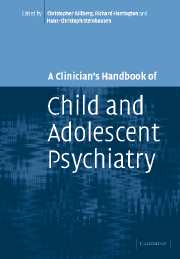Book contents
- Frontmatter
- Contents
- Preface
- List of contributors
- 1 Brain disorders
- 2 Substance use disorders
- 3 Schizophrenia and schizophrenia-like disorders
- 4 Affective disorders
- 5 Anxiety disorders
- 6 Obsessive-compulsive disorders
- 7 Adjustment disorders
- 8 Post-traumatic stress disorder
- 9 Functional somatic symptoms and somatoform disorders in children
- 10 Eating disorders: anorexia nervosa and bulimia nervosa
- 11 Sleep disorders
- 12 Personality disorders
- 13 Mental retardation/learning disability
- 14 Specific developmental disorders of speech and language
- 15 Reading and other learning disorders
- 16 Autism spectrum disorders
- 17 Hyperkinetic disorders
- 18 Conduct disorders
- 19 Elective mutism
- 20 Attachment and disorders of attachment
- 21 Tic disorders
- 22 Elimination disorders: enuresis and encopresis
- 23 Physical and sexual abuse
- 24 Gender identity disorders
- Index
- References
16 - Autism spectrum disorders
Published online by Cambridge University Press: 06 August 2009
- Frontmatter
- Contents
- Preface
- List of contributors
- 1 Brain disorders
- 2 Substance use disorders
- 3 Schizophrenia and schizophrenia-like disorders
- 4 Affective disorders
- 5 Anxiety disorders
- 6 Obsessive-compulsive disorders
- 7 Adjustment disorders
- 8 Post-traumatic stress disorder
- 9 Functional somatic symptoms and somatoform disorders in children
- 10 Eating disorders: anorexia nervosa and bulimia nervosa
- 11 Sleep disorders
- 12 Personality disorders
- 13 Mental retardation/learning disability
- 14 Specific developmental disorders of speech and language
- 15 Reading and other learning disorders
- 16 Autism spectrum disorders
- 17 Hyperkinetic disorders
- 18 Conduct disorders
- 19 Elective mutism
- 20 Attachment and disorders of attachment
- 21 Tic disorders
- 22 Elimination disorders: enuresis and encopresis
- 23 Physical and sexual abuse
- 24 Gender identity disorders
- Index
- References
Summary
Introduction
Some children are less socially interactive and communicative than others. When the combination of social and communication problems takes on the quality of a clinically severely impairing condition one needs to consider the possibility of a disorder of social interaction, particularly one that may fall under the diagnostic umbrella of ‘autism spectrum disorders’.
Autism was first delineated as a syndrome of childhood onset by Leo Kanner in the US in the 1940s. Long before that – at the turn of the eighteenth century – classic autism cases had been described by John Haslam in the UK and Jean Itard in France. The word autism (from the Greek autos for self) was introduced by Eugen Bleuler to depict the self-centred thinking believed to be typical of schizophrenia. Considered by Kanner to be a discrete disease entity, early infantile autism was conceptualized as an extremely rare disorder, and one which would be easy to identify and diagnose. It was only in the early 1980s that the concept of autism spectrum disorder was introduced by Wing and Gillberg. Wing put forward the notion of a fairly specific triad of impairments of social, communicative and imaginative functioning as being at the basis of all autism spectrum disorders. She also coined the term Asperger's syndrome for the kind of ‘high-functioning’ autism spectrum disorder described originally by Hans Asperger (who used the term autistic psychopathy) at about the same time that Kanner described his more ‘low-functioning’ variant of autism.
- Type
- Chapter
- Information
- A Clinician's Handbook of Child and Adolescent Psychiatry , pp. 447 - 488Publisher: Cambridge University PressPrint publication year: 2006
References
- 3
- Cited by



